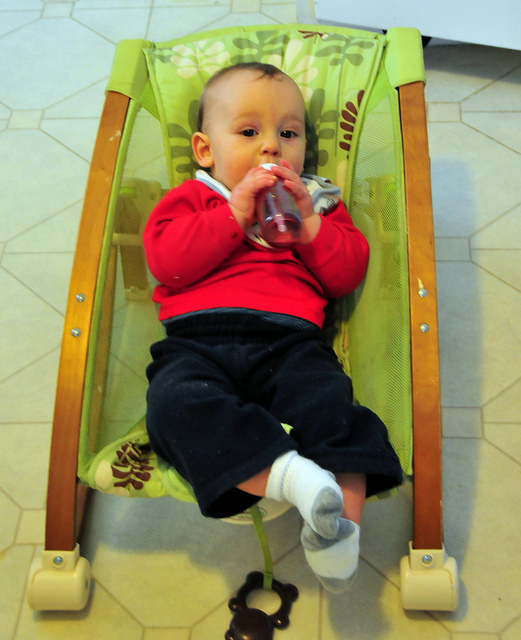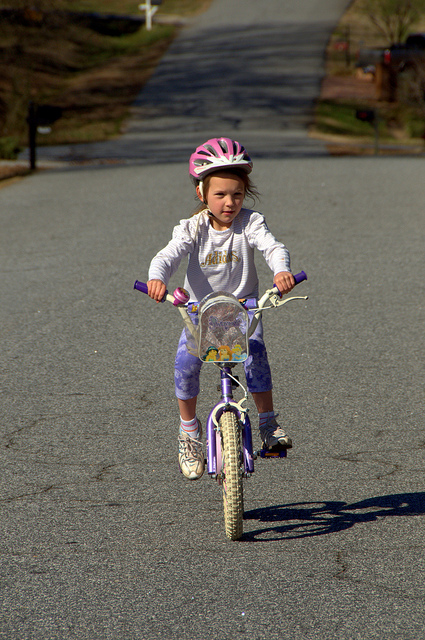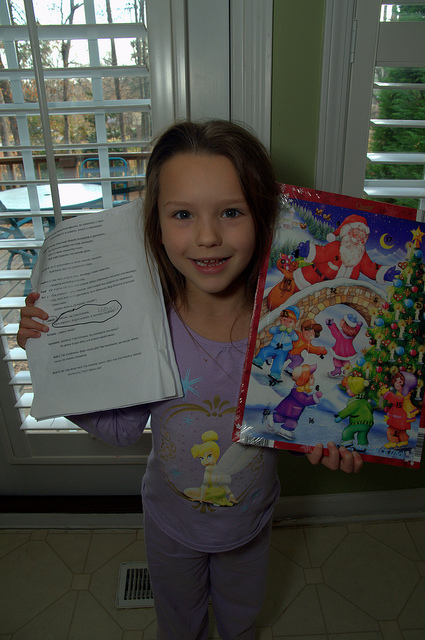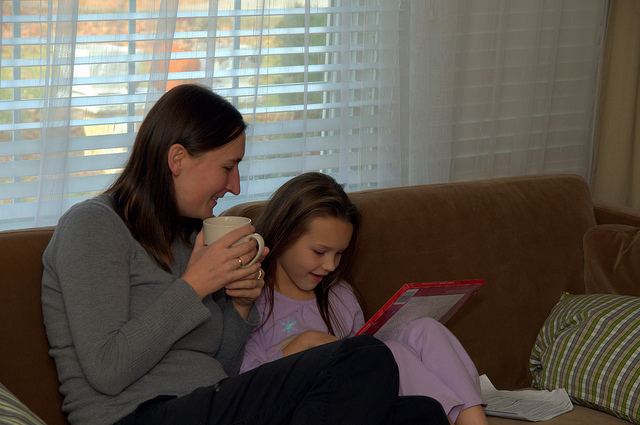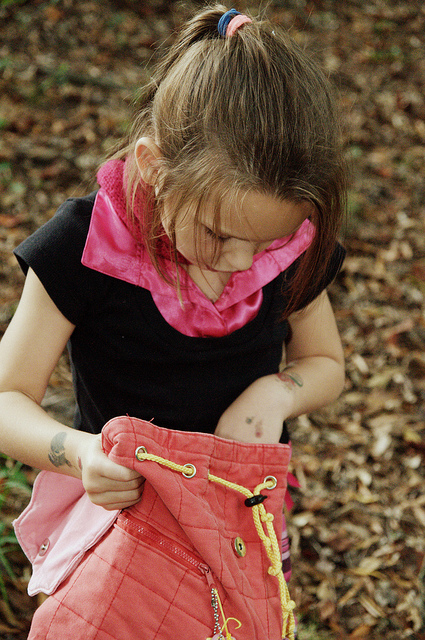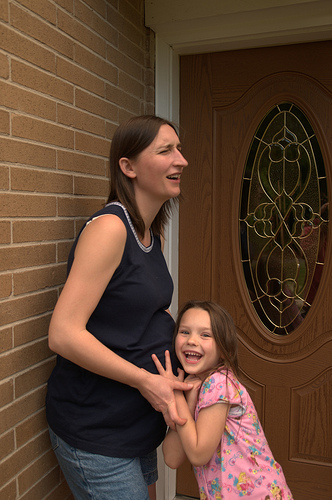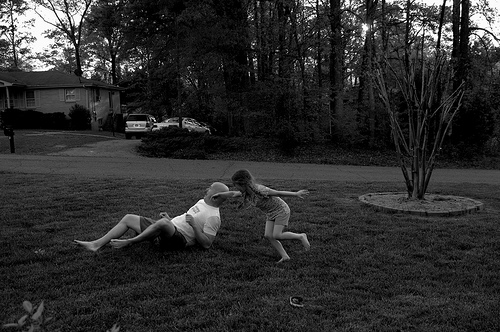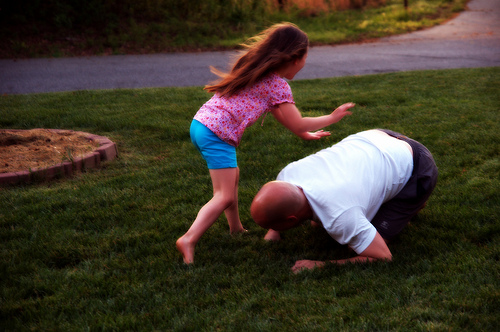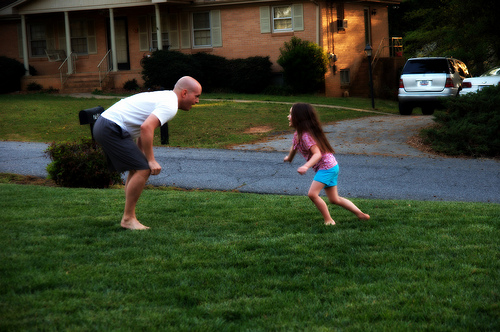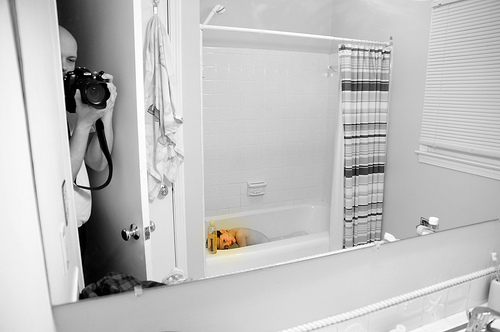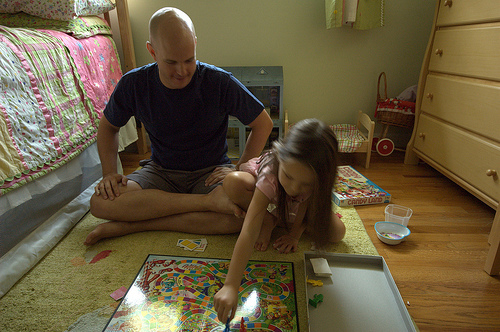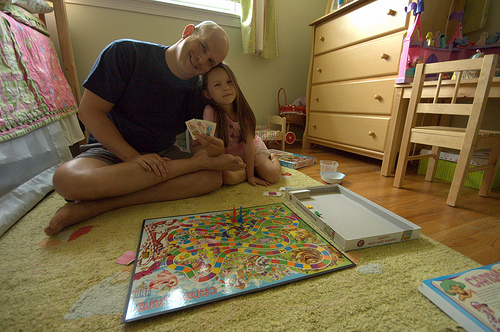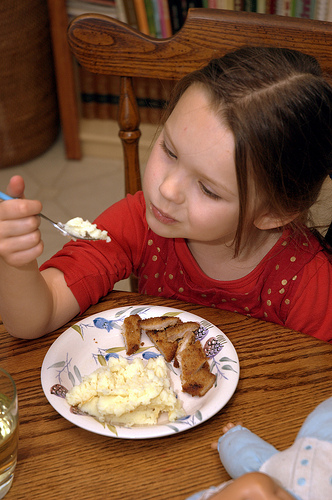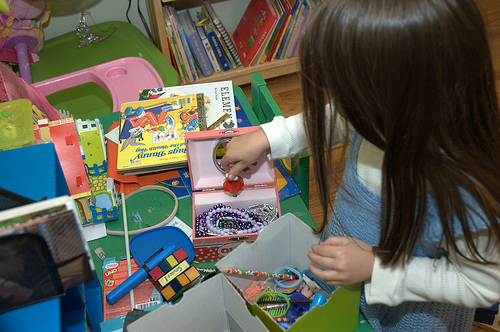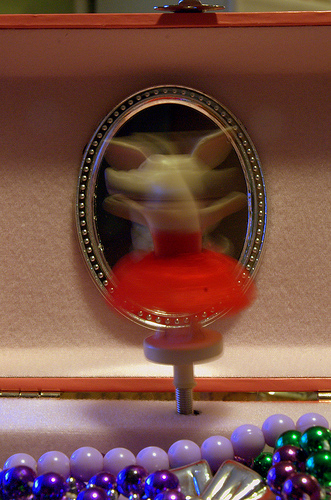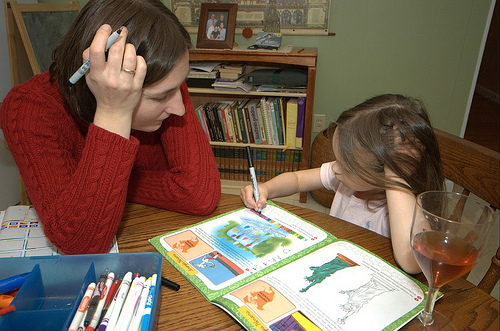Feeding and Sleeping
 He sits on my lap, Friday night and he’s tired. His head resting on my chest, he slowly opens his mouth as the spoon approaches. The pureed fruit in his mouth, he mushes it against his gums, swallows, and looks up at me. His glassy eyes stare off into the distance, and a balled fist slowly comes up, rubs an eye to the accompaniment of a little fuss. I feed him the entire jar of fruit, and it’s clear that he won’t last much beyond the last bite. Within a few minutes, we’re upstairs, his head on my shoulder as I pace about the darkened room. Moments later, he’s asleep.
He sits on my lap, Friday night and he’s tired. His head resting on my chest, he slowly opens his mouth as the spoon approaches. The pureed fruit in his mouth, he mushes it against his gums, swallows, and looks up at me. His glassy eyes stare off into the distance, and a balled fist slowly comes up, rubs an eye to the accompaniment of a little fuss. I feed him the entire jar of fruit, and it’s clear that he won’t last much beyond the last bite. Within a few minutes, we’re upstairs, his head on my shoulder as I pace about the darkened room. Moments later, he’s asleep.
The great honor of being a parent is being present in those moments of ultimate trust, those moments that make us so very mortal. I am responsible for two of his most basic, mortal needs: food and a quiet, safe place to sleep. As the Girl grows more independent, these needs come less immediately from my hands: she takes food out of the refrigerator for herself; she prepares her own snacks and even helps with her own meals. It’s easy to take those basic responsibilities for granted with her. But with him, K and I are still everything — for a while.
Beginnings
First, Last, and Only
A local priest, when discussing the Liturgy of the Eucharist — which never changes, from day to day, week to week, year to year; in other words, something repeated hundreds and then thousands of times — discussed how it might be easy simply to drift into auto-pilot (auto-priest?) and run through the liturgy without thinking, without really being there. He told us his secret for preventing such rote recitation is a prayer in which he asks for the grace to say the Mass as if it were his first Mass, his last Mass, his only Mass.
It might not be a bad way to approach every task.
I think of the excitement I felt every single “first” day I have had in the classroom: the first day at a new school, the first day ever in front of the classroom, the first day of a new school year, the first day back from a long break. Each and every first day has its own unique excitement, but the fact that it is exciting is the common element. By day sixty-five, that excitement seems somehow to have vanished, or at least diminished. The result is sometimes drudgery.
I think of the excitement I felt the first time I held our daughter. Such a charge, such a responsibility, such a humbling moment. Yet as the years pass and the fussing and independence increase, that energy sometimes seems a little tired. The daily routine, with its predictability, numbs the sense of wonder if one is not careful. Children are blessings, but the sometimes simply wear one down, and while I feel like a “bad parent” for admitting it, I’m sure it will happen with our son as well. It’s simply easier to focus on the now, which can be frustrating, than the thrill that still resonates but sometimes seems hushed.
I think of the heart-stopping moment when I asked K to marry me, and while I love her more now than I did then, and will love her more tomorrow — more deeply, more maturely — than I do today, there are moments when we grate on each other. It’s only natural. Still, in those moments, for the briefest flicker of time, that thrill seems gone. I know it will return; I know it never left; but in my human weakness, I can still focus on that moment and wallow in it for a while.
So what if I could live every moment as if it were my first, last, and only in front of a classroom; my first, last and only with my children; my first, last, and only with my wife. What if I could simply remember to reach each second as if it were my first, last, and only? Could I stand the intensity? The joy?
Up the Street
I grew up in a closed environment, literally. There was one way in or out of our housing subdivision, a fact that was of great solace to my mother as I was growing up: now strangers just “passing through.” And so I had almost complete freedom to go wherever I wanted in our neighborhood while growing up.
The only rule was that I had to be able to hear Dad whistle and get back within a reasonable amount of time.
I wish we lived in such a neighborhood now, for every time the Girl is outside playing alone, I’m a little edgy. It’s unlikely anyone would be just “passing through,” and it’s unlikely that anything would happen to her. Yet Amber Alerts, urban legend, and the Jaycee Lee Dugard case make a slightly paranoid father like me more so.
And so when she heads up the street to visit a friend, I stand at the end of our driveway and watch her head up. The friend’s parents do the same when he (or they) come back down to our place. It’s a simple enough matter, but I watch her bouncing up the street and realize, not for the first or last time, that she’s growing up, that she’s journeying from home and toward independence with a rapidity I’d been warned about but doubted for myself. And it will all repeat itself with the Boy, but I’ll be more prepared by then. I hope.
Trusty
“Will you need your trusty gloves?” the Girl asks. We’re getting ready to go another backyard adventure — our own little version of the Backyardigans — and she is packing her bag. Among other things, she has retrieved her and my work gloves (in as much as hers are work gloves), but she can’t decide if we need them.
“Go ahead and pack them,” I tell her, and we’re off — first for a series of pictures.
“When I say ‘snap,’ you take the picture,” she instructs. She says it three times; I take three pictures. Simple.
As we march through the backyard, I learn that everything is “trusty” today: I have with my my trusty camera; she has packed her trusty binoculars; she’s worried about her gloves in her trusty bag.
Everything is so trusty, and I ask her what it means to be “trusty.”
“That means it knows you can trust it,” she explains.
And it gives me pause. In that case, am I trusty? As a parent, I almost assume I’m trusty. Perhaps it’s parents’ eternal worry that they are never as trusty as their children assume and need them to be. Maybe it’s easier said than done. There are certainly times when doubt seems to be the only appropriate response — a moment of reflection that makes us think, “I guess I could always do better.”
In the end, I know I always want my children to think of me as their “trusty Tata,” and I always worry a bit that I’m not living up to that.
Cartoons: A Father’s Perspective
It was a gradual change, so gradual that we really only noticed it when it became a frequent-enough occurrence to get K and me talking about how much time the Girl had been spending in time out.
“Where did she get that?” we asked each other after the Girl had mouthed of again after just coming out of time out. It was a sassy, arrogant, and cruel tone of voice.
“No one talks to her that way here,” I said, “so there’s only one place she could have learned it: television.”
For years, whenever I was walking in some department store and a voice from a little kiosk beckoned me over to look at all the advantages of Direct TV, I could stop the conversation immediately by stating semi-truthfully, “We don’t have a television.” It wasn’t the whole truth: we had Nana’s and Papa’s old television in the computer room hooked up to a buggy DVD player, but “We don’t have a television” was more convenient (and close enough to the truth) than “We have a television, but it’s only hooked up to a DVD player; we have no cable service, and we’re not interested in it.” Somewhat reluctantly, though, we bought a small home theater system a year or so ago, and now that it’s wirelessly hooked up to our Netflix account, we can sort of watch television like “normal” people. It led the Girl into whole new realms of cartoon viewing.

Ay, there’s the rub.
“Where could she have gotten it” was only a rhetorical question because we both knew that she had spent time only with family and one close friend — not enough to explain the attitude, the sass, the trying to act like a grownup in five-year-old shorts. We sat and discussed the situation, narrowing it down quickly to two cartoons in particular: Horseland and the newest incarnation of My Little Pony that includes the deceptive subtitle, “Friendship is Magic.”

I thought back to all the snippets of these shows I’d watched — and a couple of episodes I’d watched almost entirely — and realized that both shows have characters that behave in just this sassy, nasty manner. “Well fine. I never liked it in the first place!” Things like that. Sure, by the end of the episode, all has worked out (after all, “Friendship is Magic”), but the behavioral model was still there, and the Girl had picked up on it.
We sat down with the Girl and talked about what was going on. Informed of our decision to eliminate Horseland and My Little Pony as well as to curtail general television watching, the Girl sniffled a little, but seemed fine.
A couple of weeks passed. I’d even forgotten about the two offending shows. Then:Â “Have you noticed how much L has changed in the last two weeks? The snotty, sassy little brat has disappeared and our sweet girl has returned.”
This brings up the obvious question: what affect do media have on children’s behavior? In many ways, it’s certainly a chicken/egg mystery: culture influences what is acceptable in the arts (and I use that term loosely with most television programming), and the arts in turn teach members of society (often unawares) what acceptable society members find interesting and amusing. I know for certain, though, that the behavior modeled in the cartoons showed up in our daughter. This might be a function of age: younger children are less critical of the influences that affect them. Yet once a model, always a model: it seems that the longer one watches television uncritically, the more of an unconscious influence it exerts. Certainly that’s what advertisers count on, to some degree.
But was it always like this? Were cartoons always issues of concern with parents? I certainly remember comments from my parents about how violent some cartoons are. Episodes of Tom and Jerry, Roadrunner, and many others always involve seemingly countless instances of extreme violence, acts which children are supposed to laugh at — and do laugh at. Yet it seems more likely that a child will take on the sarcastic, disrespectful tone of voice she hears in an episode of Horseland than, say, she will drop an anvil on a friend’s head. Then again, tone down the severity of the violence to a slap and I suppose they’re equally likely. Still, tone of voice is something that is not even necessarily regulated automatically in children, so it seems more influential. To see the changes since I was watching cartoons, though, one only has to look in an average classroom to see that the uptick in general disrespect is significant, whereas there was never a real corresponding increase in violence (though there has been a significant increase).
The change is most noticeable when comparing today’s cartoons to some created in the 1950’s and 1960’s. Still more noticeable are the differences compared to cartoons from that era that rely totally on visuals. I’m thinking here of two shows in particular.
Koziołek Matołek
Originally a comic from the 1930’s, Koziołek Matołek (“Matołek the Goat”) follows the adventures of Matołek as he searches out a mythical city were goat shoes are made. Matołek is goofy, clumsy, and a bit silly, but always naive and pure.
Krtecek (“Krecik” in Polish)
An import from Czechoslovakia, Krecik was the product of the 1950’s, and it shows. The first episode shows a certain kind of self-reliance common to the times but strangely foreign to most of us today, and it certainly illustrates a kind of innocence lacking in many of the cartoons the Girl is drawn to.
Further Information
Sharing
“Name something you don’t like to share.”
Plinky
Shouldn’t the selfless answer be something along the lines of “Absolutely nothing?” As a parent who is always working to teach my daughter (and soon, son) to share, I wonder if this isn’t the perfect way to set an example. “Look, my child: there’s absolutely nothing I would not share with you. I have my ice cream, but I’m only happy if it’s our ice cream. In fact, it gives me more joy to give it all to you than simply to share it.” Indeed, in such “sharing,” I would certainly be getting the better end of the deal: ice cream melts, no matter what; joy lingers.
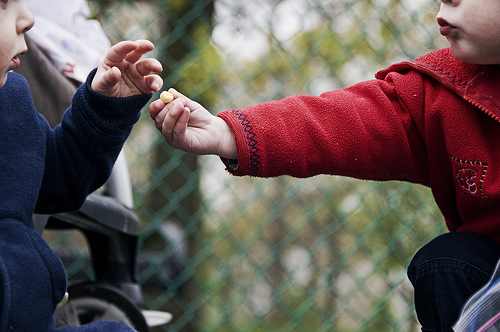
Yet isn’t that also the reckless answer? As with most questions, the more one thinks about this, the broader the potential. Do I want to share my sorrows with my children? Do I want to share my pain?
And deeper still: if I don’t want to share my sorrows with my children, why not? It would only be shielding them artificially from what they themselves would experience, and if I share my sorrow, I can control the dose. If I don’t want to share my pain, then how can I expect them to share theirs with me, which is much more important?
Relationships
The Girl has been the center of a small cluster of orbiting adults for her entire life. Mama, Tata, Nana, Papa, Babcia, Dziadek — all circle around her in their own cycles and epicycles, drifting into apogee, out of perigee, but always circling.
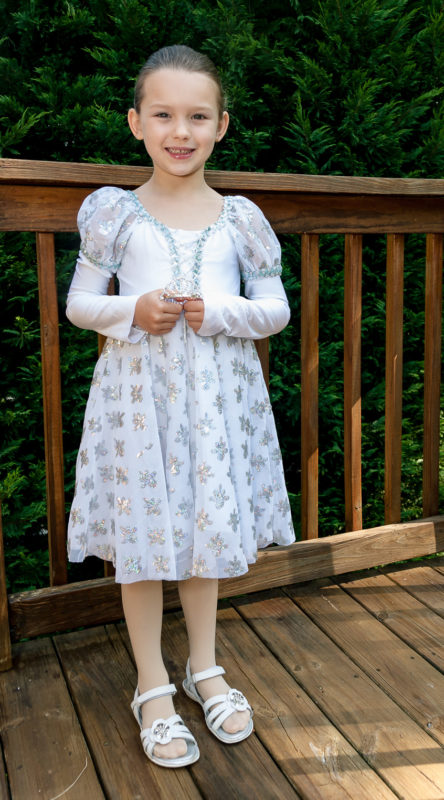
It’s been all about her dance rehearsal, her play dates, her mini photography sessions, her wants and needs.
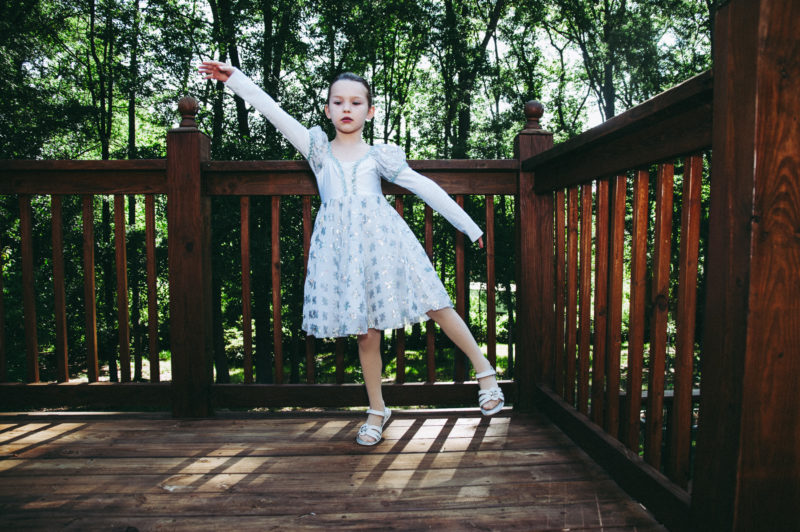
As she has spun, so we have rotated around her.
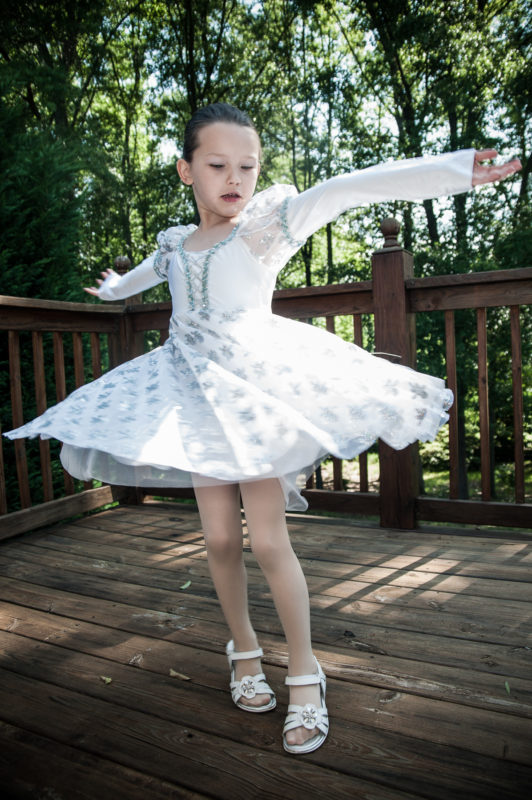
But now there’s competition. “The boy” has become a newly frequent tag for posts here, and the Girl is likely beginning to wonder just how many pictures of a baby sleeping we can possibly take. And she’s beginning to wonder just how much one little caterpillar can cry.
It’s a learning experience in countless ways. The Girl is learning she’s no longer the center; we’re learning now to make her realize that it’s now simply an elliptical orbit, with two foci.

A wise web visitor — as well as others — once pointed out that we’ll need to work on the sibling relationship as well. It’s a little trickier, because making the Girl realize she’s not suddenly an outsider is something within my control: I can take positive steps to affect that, like spending the afternoon with her riding bikes as we did today. The sibling relationship seems at first blush more like a “lead a horse to water” situation
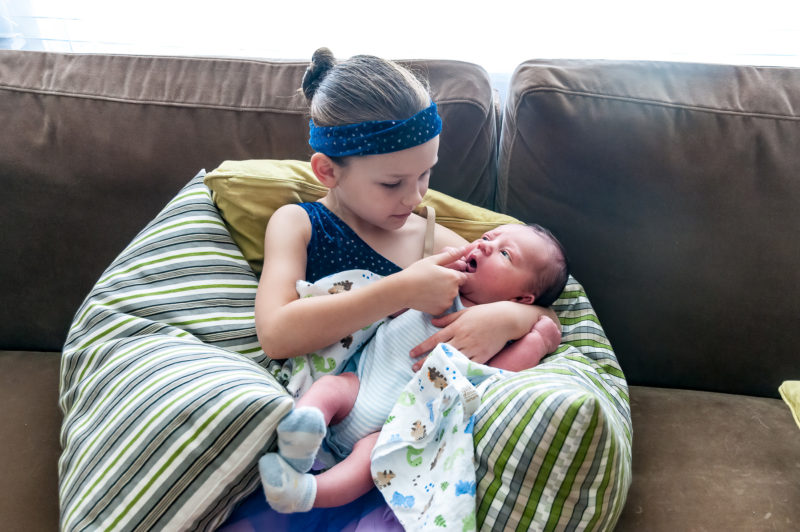
Yet there is an initiative from the Girl herself. Irritation about crying has been transformed into self-appointed pacifier duty: “When he spits it out, I’ll get it!” she proclaims.

And of course she’s just dying to hold him.
Surprise!
Afternoon Play
Summer always had a dream-like feel to it when I was a young kid. Even though it seemed never to arrive, it had an aura of endlessness once it finally did. Two and a half months seem a lot longer when you’re five.
And waiting for summer vacation when the weather is already warm and everything around you is beginning to scream, “It’s summer!” (even though it’s technically spring) makes for itchy feet.
So we decided to get a jump on summer today, though, with some tag in the front yard. We ran around the yard, fell on each other, and rolled around in the grass, winded and sure that the moment would last for ever.
At least I was sure. The Girl, not so much. She was up again, ready to go.
“Come on, Tata! I’m it!”
Lent 2012: Day 31
 Lent is about sacrifice, and a significant part of our everyday reality is sacrifice in the form of delayed gratification, when we sacrifice the immediate satisfaction of our desires for some further, greater good. For example, we could buy that new camera lens we want (and I have been drooling over Nikon’s 17-55 2.8 for some time) on credit and have immediate gratification; delaying said gratification by saving for the lens (and at $1,500, that particular lens would take quite a bit of saving of my personal spending money) means not racking up unnecessary debt that could hurt us in the long run. So we delay gratification for a good that is even further in the distance, and in this case, hypothetical. But the immediate price is a sacrifice of potential joy.
Lent is about sacrifice, and a significant part of our everyday reality is sacrifice in the form of delayed gratification, when we sacrifice the immediate satisfaction of our desires for some further, greater good. For example, we could buy that new camera lens we want (and I have been drooling over Nikon’s 17-55 2.8 for some time) on credit and have immediate gratification; delaying said gratification by saving for the lens (and at $1,500, that particular lens would take quite a bit of saving of my personal spending money) means not racking up unnecessary debt that could hurt us in the long run. So we delay gratification for a good that is even further in the distance, and in this case, hypothetical. But the immediate price is a sacrifice of potential joy.
The Girl has been saving for a Barbie camper for months now. Granted, it only began a little before Christmas, but five-year-old time is like dog-years: it’s all relative. She gets a little cash here and there, from us and her grandparents, and this week, she made it: $70, the Wal-Mart website price.
So this evening, we went to Wally-world to buy it, only to find the price there was $94. I took it to customer service to inquire about the justification for the price difference. It turned out, they were aware of it — and they did nothing about it.
“We’ll price-match with a competitor…” began the customer service rep.
“But not with yourself,” I finished.
“Right. Not even store to store.”
I sensed a crisis brewing, but the Girl handled it marvelously: a few whimpers of disappointment but nothing significant.
Back home, we shopped around and found it on sale for $50. And now the Girl has a good start on her savings for a Barbie house — and a lesson learned about delayed gratification.
The Bath
During the first days of the Girl’s life, giving her a bath was, in K’s and my new-parent, paranoid mind, a two-person job. So delicate, cradled in a tightly netted support that actually sat above the water in a small, counter-top, plastic wash tub. Eventually, the netted support disappeared, and the Girl merely sat in the tub. After three or so years of that (including an eventual transferring of the plastic tub from the counter top to the adult-size bath tub), the Girl graduated to the main tub itself.
Throughout it all, though, it’s been my job (primarily) to bath her. And as she’s moved from tub to tub, my role has diminished.
Lately, I’ve been happily reduced to the role of water-pourer, which leaves me with time to do other things.
Tough Lessons
 Because one of my plugins broke with the upgrade to WordPress 3.3, I have to click over to Flickr and manually grab the code for each image I want to insert. In some ways, it would be easier simply to upload them directly to this site, but we use Flickr as a mastery back-up for our best photos — the ones we absolutely don’t want to lose — so in the long run, it’s worth the extra step. But it does mean some clicking: Click on the picture. Click on the “Share” button. Select the text and copy. Click to the new window — you get the point.
Because one of my plugins broke with the upgrade to WordPress 3.3, I have to click over to Flickr and manually grab the code for each image I want to insert. In some ways, it would be easier simply to upload them directly to this site, but we use Flickr as a mastery back-up for our best photos — the ones we absolutely don’t want to lose — so in the long run, it’s worth the extra step. But it does mean some clicking: Click on the picture. Click on the “Share” button. Select the text and copy. Click to the new window — you get the point.
Still, as far as sharing goes, this is fairly painless, because one of the hardest things to learn is the gift of sharing. I say “gift of sharing” as if it’s something easy for me to do. It’s not. I doubt it’s easy for anyone in all situations. We all have this or that which we hang on to with clinched fists even when we aren’t aware of how are knuckles are turning white.
For the Girl, it’s Wawel’s candy, “Kasztanki.” L is simply obsessed with them. This is partially because of their rarity: they’re not readily available in the South. (One might find them in Polish stores up north, but not down here.) Babcia sends them to the Girl on a fairly regular basis, but from time to time, she does run out, and then it’s a period of slow heartbreak.
Tonight, we suggested that L share her favorite candy with Nana and Papa so they could see what all the fuss was about. Judging from her expression, one would think we’d asked her to give up a kidney or sacrifice her life. Eventually she relented, though not without a bit of persuasion.
I suppose we all take some persuading to share some things.
Games
It’s a lifelong process, learning how to lose. I’m thirty-some years older than the Girl, but I still fight the frustration of loss just as much as she. I could contend that there is a difference: losing at games of chance doesn’t phase me because it’s a question of luck; losing at games of skill–read: chess–does bother me when I feel I made a stupid mistake. Such distinctions are lost on the Girl, though: losing is losing is losing. It all hurts.
We’ve been working with the learning how to lose (and to a lesser degree, how to win gracefully) with Candy Land for ages. We’ve seen some real improvement: the complete hysterical fits have disappeared, replaced by a temporarily pout and an extended lower lip. In fact, things are going so well that I’ve stopped my Machiavellian parenting technique of stacking the deck to make sure she loses at least once or, if needed, wins once.
Yet sometimes that dimension of untinkered-with chance provides some amusement: three candy cards within four turns for me resulted in some whiplash-inducing jumps around the board and laughs for the Girl — even when I was surging ahead. Perhaps she knew the next card would bring me back to Earth.
Polska Dziewczyna
Kotlet schabowy z ziemniakami. She loves the pork — though we sell it to her as chicken — but she has to give the potatoes a bit of thought.
Still, she’s a Polish girl, through and through. Her favorite meal, the thing she would eat daily, the dish that gets her squealing with delight when she learns it’s on the day’s dinner menu: barszcz.
The Artist
“I’m an artist,” L declares as she’s drawing on the driveway. “No one knows I’m an artist at school, and I have to keep it a secret,” she continues. “If anyone finds out, they’ll tell the teacher. Then the teacher will come to me and ask if I’m an artist.” She pauses for a moment, inspecting her work, then continues the creation and the explanation.
“If they ask that, I’ll have to tell them that I am but that it was supposed to be a secret.” She looks up, holds her hands out to her sides, palms up, lowers one eyebrow, and does her best to look adult: “That’s why I have to keep it a secret.”
Treasure
A four-year-old has treasure stored up in every corner of the house. There’s the princess umbrella that sits in the toy basket downstairs, ready for deployment. There’s the scooter downstairs, festooned with princess regalia, parked by the pink bike. There’s a bookshelf packed with books, new and old, tall and short, thick and slim.
And then there’s the jewelry.
All L’s treasure had its own, proper, fitting place before today except for the jewelry.
A small but colorful cardboard from Ikea held L’s beads and rings, her bracelets and necklaces, her charms and her gems. And so when she saw the jewelry box at Barnes and Noble this afternoon, there was no question. She’d come with money sent from Poland with the intention of buying a book.
She left with a new treasure,
to hold all her other treasures.
Studying
Bibo, ergo…
The Girl, tucked in bed, is trying to convince me that, despite having trekked down the hall just six minutes ago, she has to go again.
“Tata, I’m lying in bed,” she begins, thrusting her right fist out in front of her. “I’ve been drinking juice,” she continues, thrusting her left fist out as well. They float there, swaying back and forth as if she doesn’t know what she’s going to do with them.
She claps them together, providing an apt conclusion: “When the two halves meet…”
